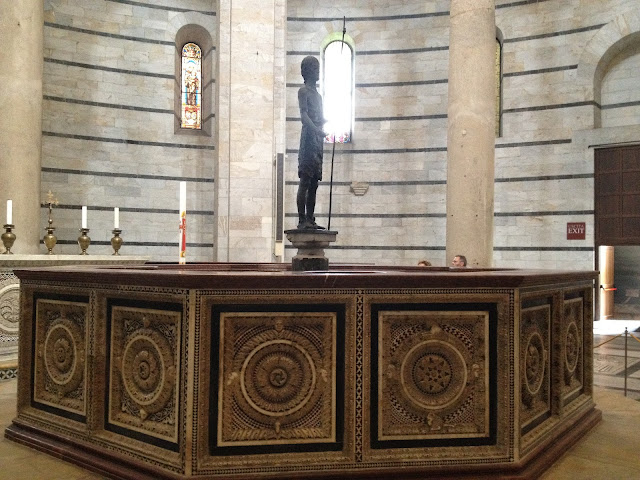Our investigation of the life and times of Galileo continues! On Monday we took a trip to Pisa, where Galileo was born. It was a cool and breezy day, which made for a nice change from the more usual sticky heat. With the help of a local guide, we explored the Campo dei Miracoli, where the cathedral, baptistery, and, of course, the leaning tower are situated. It was very cool. The baptistery is where Galileo was baptized, which made for a neat photo opportunity.
The Baptistery.
The font where Galileo was baptized. Wheee!
According to our guide, this little figure of Hercules (in the center) was the first sculpted naked man to appear in a Christian church. Neat.
There wasn't much else to see in Pisa, so after lunch we hopped back on the train and returned to Florence.
Yesterday, we fast-forwarded to the end of Galileo's life. We started with a trip to the Museo Galileo, which has an amazing collection of scientific instruments and materials from the 15th, 16th, and 17th centuries. My kind of place. It had things like this amazing, huge armillary sphere (depicting the motions of the planets and stars in an Earth-centered universe) that was a wedding present for one of Galileo's patrons, the Grand Duchess Christina:
....as well as this example of an early "computer" -- a means of storing and categorizing information, designed originally by Athanasius Kircher, on whom I wrote my dissertation:
These are the last two surviving telescopes made and used by Galileo; below, in that fancy plaque, is the objective lens through which he first observed the moons of Jupiter:
Replicas of the equipment he designed and used to make his discoveries in physics:
.....and, of course, two of his fingers, a thumb, and a tooth, removed when he was reburied in 1733 and now preserved forever. The larger "reliquary" was lost for over a century and was only rediscovered in 2010.
After our whirlwind tour of the Museo, we headed to Santa Croce, the church where Galileo is buried, along with Michelangelo, Machiavelli, and others.
Michelangelo's tomb.
Machiavelli.
Galileo's tomb.
After staring at tombs and walking on more than a few graves set into the floor of the church, we headed outside to the quiet and beautiful cloisters where the monks used to stroll. Not a bad end to a fascinating day.
Alas, I seem to be coming down with a cold, so my last few days in Florence may not be perfect. I'm going to see as much as I can, though! We're going to visit the Duomo tomorrow (at last), and we're lucky enough to have a chance to visit the house outside Florence where Galileo was confined after his trial in 1633, and where he died in 1642. That's on Saturday.
Ciao for now!















No comments:
Post a Comment